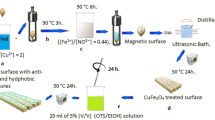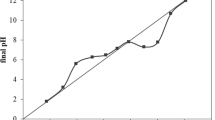Abstract
Immobilization of microorganisms on/in insoluble carriers is widely used to stabilize functional activity of microbial cells in industrial biotechnology. We immobilized Rhodococcus ruber, an important hydrocarbon degrader, on biosurfactant-coated sawdust. A biosurfactant produced by R. ruber in the presence of liquid hydrocarbons was found to enhance rhodococcal adhesion to solid surfaces, and thus, it was used as a hydrophobizing agent to improve bacterial attachment to a sawdust carrier. Compared to previously used hydrophobizers (drying oil and n-hexadecane) and emulsifiers (methyl- and carboxymethyl cellulose, poly(vinyl alcohol), and Tween 80), Rhodococcus biosurfactant produced more stable and homogenous coatings on wood surfaces, thus resulting in higher sawdust affinity to hydrocarbons, uniform monolayer distribution of immobilized R. ruber cells (immobilization yield 29–30 mg dry cells/g), and twofold increase in hydrocarbon biooxidation rates compared to free rhodococcal cells. Two physical methods, i.e., high-resolution profilometry and infrared thermography, were applied to examine wood surface characteristics and distribution of immobilized R. ruber cells. Sawdust-immobilized R. ruber can be used as an efficient biocatalyst for hydrocarbon transformation and degradation.








Similar content being viewed by others
References
Adamczyk Z, Jaszczółt K, Siwek B (2005) Irreversible adsorption of colloid particles on heterogeneous surfaces. Appl Surf Sci 252:723–729. doi:10.1016/j.apsusc.2005.02.053
Bayoudh S, Othmane A, Bettaieb F, Bakhrouf A, Ben Ouada H, Ponsonnet L (2006) Quantification of the adhesion free energy between bacteria and hydrophobic and hydrophilic substrata. Mat Sci Eng C 26:300–305. doi:10.1016/j.msec.2005.10.045
Borghol N, Mora L, Jouenne T, Jaffézic-Renault N, Sakly N, Duncan AC, Chevalier Y, Lejeune P, Othmane A (2010) Monitoring of E. coli immobilization on modified gold electrode: a new bacteria-based glucose sensor. Biotechnol Bioprocess Eng 15:220–228. doi:10.1007/s12257-009-0146-4
Bos R, van der Mei HC, Busscher HJ (1999) Physico-chemistry of initial microbial adhesive interactions—its mechanisms and methods for study. FEMS Microbiol Rev 23:179–230
Carnazza S (2007) New advances in cell adhesion technology. In: Bellucci S (ed) Nanoparticles and nanodevices in biological applications. Lecture notes in nanoscale science and technology 7. Springer, Berlin, pp 69–130
Cheng KC, Demirci A, Catchmark JM (2010) Advances in biofilm reactors for production of value-added products. Appl Microbiol Biotechnol 87:445–456. doi:10.1007/s00253-010-2622-3
Choi YS, Lee CS (2011) Generation of protein and cell microarrays on functionalized surfaces. In: Khademhosseini A (ed) Biological microarrays: methods and protocols, methods in molecular biology, vol 671. Springer, Heidelberg, pp 207–217
Fernandes P (2006) Immobilization of cells with transition metal. In: Guisan JM (ed) Methods in biotechnology: immobilization of enzymes and cells, 2nd edn. Humana, Totowa, pp 367–372
Gambi CM, Giordano R, Chittofrati A, Pieri R, Baglioni P, Teixeira J (2005) Small-angle neutron scattering of ionic perfluoropolyether micellar solutions: role of counterions and temperature. J Phys Chem B 109:8592–8598. doi:10.1021/jp0405815
Han YS, Yoon SM, Kim DK (2000) Synthesis of monodispersed and spherical SiO2-coated Fe2O3 nanoparticle. Bull Korean Chem Soc 21:1193–1198
Hori K, Matsumoto S (2010) Bacterial adhesion: from mechanism to control. Biochem Eng J 48:424–434. doi:10.1016/j.bej.2009.11.014
Hori K, Watanabe H, Ishii S, Tanji Y, Unno H (2008) Monolayer adsorption of a “Bald” mutant of the highly adhesive and hydrophobic bacterium Acinetobacter sp. strain Tol 5 to a hydrocarbon surface. Appl Environ Microbiol 74:2511–2517. doi:10.1128/AEM.02229-07
Huber B, Riedel K, Hentzer M, Heydorn A, Gotschlich A, Givskov M, Molin S, Eberl L (2001) The cep quorum-sensing system of Burkholderia cepacia H111 controls biofilm formation and swarming motility. Microbiology 147:2517–2528
Ivshina IB, Kuyukina MS, Philp JC, Christofi N (1998) Oil desorption from mineral and organic materials using biosurfactant complexes produced by Rhodococcus species. World J Microbiol Biotechnol 14:711–717
Keshavarz T (2005) Production of biopharmaceuticals through microbial cell immobilization. In: Nedovič V, Willaert R (eds) Applications of cell immobilisation in biotechnology. Springer, Netherlands, pp 407–422
Khopade A, Biao R, Liu X, Mahadik K, Zhang L, Kokare C (2012) Production and stability studies of the biosurfactant isolated from marine Nocardiopsis sp. B4. Desalination 285:198–204. doi:10.1016/j.desal.2011.10.002
Kinsinger RF, Shirk MC, Fall R (2003) Rapid surface motility in Bacillus subtilis is dependent on extracellular surfactin and potassium ion. J Bacteriol 185:5627–5631. doi:10.1128/JB.185.18.5627-5631.2003
Kondo A, Ueda M (2004) Yeast cell-surface display—applications of molecular display. Appl Microbiol Biotechnol 64:28–40. doi:10.1007/s00253-003-1492-3
Kulicke WM, Arendt O, Berger M (1998) Characterization of hydroxypropylmethylcellulose-stabilized emulsions. Colloid Polym Sci 276:1019–1023. doi:10.1007/s003960050341
Kuyukina MS, Ivshina IB (2010a) Application of Rhodococcus in bioremediation of contaminated environments. In: Alvarez HM (ed) Biology of Rhodococcus, microbiology monographs, vol 16. Springer, Berlin, pp 231–262
Kuyukina MS, Ivshina IB (2010b) Rhodococcus biosurfactants: biosynthesis, properties, and potential applications. In: Alvarez HM (ed) Biology of Rhodococcus, microbiology monographs, vol 16. Springer, Berlin, pp 291–313
Kuyukina MS, Ivshina IB, Philp JC, Christofi N, Dunbar SA, Ritchkova MI (2001) Recovery of Rhodococcus biosurfactants using methyl tertiary-butyl ether extraction. J Microbiol Methods 46:149–156
Kuyukina MS, Ivshina IB, Gavrin AY, Podorozhko EA, Lozinsky VI, Jeffree CE, Philp JC (2006) Immobilization of hydrocarbon-oxidizing bacteria in poly(vinyl alchohol) cryogels hydrophobized using a biosurfactant. J Microbiol Methods 65:596–603. doi:10.1016/j.mimet.2005.10.006
Kuyukina MS, Ivshina IB, Serebrennikova MK, Krivoruchko AV, Podorozhko EA, Ivanov RV, Lozinsky VI (2009) Petroleum-contaminated water treatment in a fluidized-bed bioreactor with immobilized Rhodococcus cells. Int Biodeterior Biodegrad 63:427–432. doi:10.1016/j.ibiod.2008.12.001
Ławniczak Ł, Kaczorek E, Olszanowski A (2011) The influence of cell immobilization by biofilm forming on the biodegradation capabilities of bacterial consortia. World J Microbiol Biotechnol 27:1183–1188. doi:10.1007/s11274-010-0566-5
Lehocký M, Stahel P, Koutný M, Čech J, Institoris J, Mráček A (2009) Adhesion of Rhodococcus sp. S3E2 and Rhodococcus sp. S3E3 to plasma prepared Teflon-like and organosilicon surfaces. J Mat Proc Technol 209:2871–2875. doi:10.1016/j.jmatprotec.2008.06.042
Martínková L, Uhnáková B, Pátek M, Nešvera J, Křen V (2009) Biodegradation potential of the genus Rhodococcus. Environ Int 35:162–177. doi:10.1016/j.envint.2008.07.018
Mehdi H, Giti E (2008) Investigation of alkane biodegradation using the microtiter plate method and correlation between biofilm formation, biosurfactant production and crude oil biodegradation. Int Biodeterior Biodegrad 62:170–178. doi:10.1016/j.ibiod.2008.12.001
Mukherjee S, Das P, Sen R (2006) Towards commercial production of microbial surfactants. Trends Biotechnol 24:509–515. doi:10.1016/j.tibtech.2006.09.005
Neu TR (1996) Significance of bacterial surface-active compounds in interaction of bacteria with interfaces. Micriobiol Rev 60:151–166
Page CA, Bonner JS, Kanga SA, Mills MA, Autenrieth RL (1999) Biosurfactant solubilization of PAHs. Environ Eng Sci 16:465–474
Philp JC, Kuyukina MS, Ivshina IB, Dunbar SA, Christofi N, Lang S, Wray V (2002) Alkanotrophic Rhodococcus ruber as a biosurfactant producer. Appl Microbiol Biotechnol 59:318–324. doi:10.1007/s00253-002-1018-4
Pirog TP, Shevchuk TA, Voloshina IN, Gregirchak NN (2005) Use of claydite-immobilized oil-oxidizing microbial cells for purification of water from oil. Appl Biochem Microbiol 41:51–55
Podorozhko EA, Lozinsky VI, Ivshina IB, Kuyukina MS, Krivorutchko AB, Philp JC, Cunningham CJ (2008) Hydrophobised sawdust as a carrier for immobilisation of the hydrocarbon-oxidizing bacterium Rhodococcus ruber. Biores Technol 99:2001–2008. doi:10.1016/j.biortech.2007.03.024
Quek E, Ting YP, Tan HM (2006) Rhodococcus sp. F92 immobilized on polyurethane foam shows ability to degrade various petroleum products. Biores Technol 97:32–38. doi:10.1016/j.biortech.2005.02.031
Rapp P, Gabriel-Jürgens LHE (2003) Degradation of alkanes and highly chlorinated benzenes, and production of biosurfactants, by a psychrophilic Rhodococcus sp. and genetic characterization of its chlorobenzene dioxygenase. Microbiology 149:2879–2890. doi:10.1099/mic.0.26188-0
Robatjazi SM, Shoiaosadati SA, Khalilzadeh R, Farahani EV (2012) Immobilization of magnetic modified Flavobacterium ATCC 27551 using magnetic field and evaluation of the enzyme stability of immobilized bacteria. Biores Technol 104:6–11. doi:10.1016/j.biortech.2011.11.035
Rodrigues L, van der Mei H, Teixeira JA, Oliveira R (2004) Biosurfactant from Lactococcus lactis 53 inhibits microbial adhesion on silicone rubber. Appl Microbiol Biotechnol 66:306–311. doi:10.1007/s00253-004-1674-7
Rodrigues L, Banat IM, Teixeira J, Oliveira R (2006) Biosurfactants: potential applications in medicine. J Antimicrob Chemother 57:609–618. doi:10.1093/jac/dkl024
Rose JW (2002) Dropwise condensation theory and experiment: a review. Proc Inst Mech Eng, A: J Power Energy 216:115–128
Shakerifard P, Gancel F, Jacques P, Faille C (2009) Effect of different Bacillus subtilis lipopeptides on surface hydriphobicity and adhesion of Bacillus cereus 98/4 spores to stainless steel and Teflon. Biofouling 25:533–541. doi:10.1080/08927010902977943
Škvarla J, Kupka D, Turčániová L (1998) Recent knowledge about the role of bacterial adhesion in coal preparation. Acta Montanist Slovaca 3:368–377
Tadros TF, Vandamme A, Levecke B, Booten K, Stevens CV (2004) Stabilization of emulsions using polymeric surfactants based on inulin. Adv Colloid Interface Sci 108–109:207–226. doi:10.1016/j.cis.2003.10.024
Tesch S, Gerhards C, Schubert H (2002) Stabilization of emulsions by OSA starches. J Food Eng 54:167–174. doi:10.1016/S0260-8774(01)00206-0
Tkáč J, Štefuca V, Gemeiner P (2005) Biosensors with immobilised microbial cells using amperometric and thermal detection principles. In: Nedovič V, Willaert R (eds) Applications of cell immobilisation biotechnology. Springer, Netherlands, pp 549–566
van Loosdrecht MCM, Lyklema J, Norde W, Zehnder AJB (1990) Influence of interfaces on microbial activity. Microbiol Rev 54:75–87
Waters MS, El-Naggar MY, Hsu L, Sturm CA, Luttge A, Udwadia FE, Cvitkovitch DG, Goodman SD, Nealson KH (2009) Simultaneous interferometric measurement of corrosive or demineralizing bacteria and their mineral interfaces. Appl Environ Microbiol 75:1445–1449. doi:10.1128/AEM.02039-08
Wrenn BA, Venosa AD (1996) Selective enumeration of aromatic and aliphatic hydrocarbon degrading bacteria by a most-probable number procedure. Can J Microbiol 42:252–258
Xia X, Li Y, Zhou Z, Feng C (2010) Bioavailability of adsorbed phenanthrene by black carbon and multi-walled carbon nanotubes to Agrobacterium. Chemosphere 78:1329–1336. doi:10.1016/j.chemosphere.2010.01.007
Yam KC, van der Geize R, Eltis LD (2010) Catabolism of aromatic compounds and steroids by Rhodococcus. In: Alvarez HM (ed) Biology of Rhodococcus, microbiology monographs, vol 16. Springer, Berlin, pp 133–169
Zeraik AE, Nitschke M (2010) Biosurfactants as agents to reduce adhesion of pathogenic bacteria to polystyrene surfaces: effect of temperature and hydrophobicity. Curr Microbiol 61:554–559. doi:10.1007/s00284-010-9652-z
Zhang R, Somasundaran P (2006) Advances in adsorption of surfactants and their mixtures at solid/solution interfaces. Adv Colloid Interface Sci 123–126:213–229. doi:10.1016/j.cis.2006.07.004
Acknowledgments
The research was partially supported by the grants of the Russian Academy of Sciences Presidium Program “Leaving Nature: Current State and Development Problems” (no. 01201256869) and “Molecular and Cell Biology” (no. 01201256863) and the Russian Foundation for Basic Research grant (11-04-96045-r_ural_а).
Author information
Authors and Affiliations
Corresponding author
Rights and permissions
About this article
Cite this article
Ivshina, I.B., Kuyukina, M.S., Krivoruchko, A.V. et al. Biosurfactant-enhanced immobilization of hydrocarbon-oxidizing Rhodococcus ruber on sawdust. Appl Microbiol Biotechnol 97, 5315–5327 (2013). https://doi.org/10.1007/s00253-013-4869-y
Received:
Revised:
Accepted:
Published:
Issue Date:
DOI: https://doi.org/10.1007/s00253-013-4869-y




